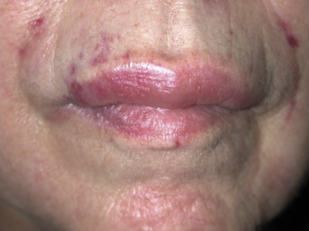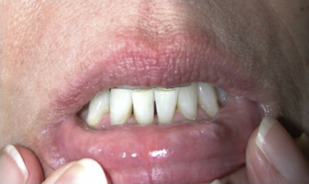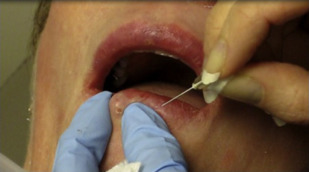The use of facial fillers has greatly expanded over the past several years. Along with increased use comes a rise in documented complications, ranging from poor cosmetic result to nodules, granulomas, necrosis, and blindness. Awareness of the potential types of complications and options for management, in addition to the underlying facial anatomy, are imperative to delivering the best patient care. This article defines the complications and how to treat them and provides suggestions to avoid serious adverse outcomes.
Key points
- •
Identification of various filler-associated adverse events.
- •
Knowledge of tips to prevent filler-associated adverse events.
- •
Recognition of vascular occlusions: how to avoid them and how to treat them.
Introduction
Facial filler injections represent an ever-expanding market of nonsurgical facial rejuvenation. Second only to botulinum toxin type A injections, soft tissue fillers comprised 2.3 million procedures performed in the United States in 2014, a 4.5% increase from the previous year. Approximately 78% (1.8 million) of these 2.3 million total dermal filler injections represent hyaluronic acid (HA) fillers. This specific popularity may be caused by the potential reversibility of the HA fillers with hyaluronidase, which allows injectors and patients the ease of dissolving unwanted filler.
Currently in the United States, the following substances have been Food and Drug Administration (FDA)-approved for treating facial rhytids: autologous fat, collagen (Evolence, Cosmoderm, Fibrel, Zyplast, Zyderm), HA (Restylane-L, Restylane Silk, Juvederm XC, Juvederm Voluma XC, Belotero Balance, Prevelle Silk, Elevess, Captique, Hylaform), poly-( l )-lactic acid (PLLA; Sculptra and Sculptra Aesthetic), calcium hydroxylapatite (Radiesse), and polymethyl methacrylate (PMMA; Bellafill, formerly known as Artefill).
Although HA fillers have been touted to be safer and thus more widespread than the other filler types, all have been associated with adverse outcomes. These complications range from localized bruising, erythema, edema, migration, allergic response, the formation of small bumps underneath the skin, to more serious sequelae, such as permanent visual loss and nerve paralysis. Although not approved for domestic use, polyacrylamide gel and other non-FDA-approved substances are injected abroad and their complications are also often managed in the United States as travelers return from overseas. Thus, awareness of the potential types of complications and options for management, in addition to the underlying facial anatomy, are imperative to delivering the best patient care.
The importance of hyaluronidase is being mentioned early in this article because of its value in treating a variety of the complications of facial fillers. Hyaluronidase has the ability to dissolve HA, which comprises most fillers injected in the United States. Its activity was first described in 1929 by Duran-Reynals. It is FDA-approved as a dispersion agent, usually for local anesthetics, which temporarily modifies the permeability of connective tissue through the hydrolysis of HA, a polysaccharide found in the intracellular ground substance of connective tissue. It is not FDA-approved for dissolution of HA and therefore use in treating complications from facial fillers is considered off-label.
Hyaluronidase has been used in ophthalmology with retrobulbar blocks since 1978. It is commercially available in the United States as Vitrase (ovine from Valeant) and Hylenex (human recombinant from Halozyme). Hyaluronidase has even been suggested as a possibility to treat non-HA fillers with the idea that increased tissue compliance may allow a non-HA emboli to pass. Approximately 30 U of hyaluronidase are needed to dissolve 0.1 mL of HA. Restylane may resolve the fastest and Belotero the slowest relative to more cross-linking in the latter. All HA fillers, however, should be degraded within 24 hours.
Introduction
Facial filler injections represent an ever-expanding market of nonsurgical facial rejuvenation. Second only to botulinum toxin type A injections, soft tissue fillers comprised 2.3 million procedures performed in the United States in 2014, a 4.5% increase from the previous year. Approximately 78% (1.8 million) of these 2.3 million total dermal filler injections represent hyaluronic acid (HA) fillers. This specific popularity may be caused by the potential reversibility of the HA fillers with hyaluronidase, which allows injectors and patients the ease of dissolving unwanted filler.
Currently in the United States, the following substances have been Food and Drug Administration (FDA)-approved for treating facial rhytids: autologous fat, collagen (Evolence, Cosmoderm, Fibrel, Zyplast, Zyderm), HA (Restylane-L, Restylane Silk, Juvederm XC, Juvederm Voluma XC, Belotero Balance, Prevelle Silk, Elevess, Captique, Hylaform), poly-( l )-lactic acid (PLLA; Sculptra and Sculptra Aesthetic), calcium hydroxylapatite (Radiesse), and polymethyl methacrylate (PMMA; Bellafill, formerly known as Artefill).
Although HA fillers have been touted to be safer and thus more widespread than the other filler types, all have been associated with adverse outcomes. These complications range from localized bruising, erythema, edema, migration, allergic response, the formation of small bumps underneath the skin, to more serious sequelae, such as permanent visual loss and nerve paralysis. Although not approved for domestic use, polyacrylamide gel and other non-FDA-approved substances are injected abroad and their complications are also often managed in the United States as travelers return from overseas. Thus, awareness of the potential types of complications and options for management, in addition to the underlying facial anatomy, are imperative to delivering the best patient care.
The importance of hyaluronidase is being mentioned early in this article because of its value in treating a variety of the complications of facial fillers. Hyaluronidase has the ability to dissolve HA, which comprises most fillers injected in the United States. Its activity was first described in 1929 by Duran-Reynals. It is FDA-approved as a dispersion agent, usually for local anesthetics, which temporarily modifies the permeability of connective tissue through the hydrolysis of HA, a polysaccharide found in the intracellular ground substance of connective tissue. It is not FDA-approved for dissolution of HA and therefore use in treating complications from facial fillers is considered off-label.
Hyaluronidase has been used in ophthalmology with retrobulbar blocks since 1978. It is commercially available in the United States as Vitrase (ovine from Valeant) and Hylenex (human recombinant from Halozyme). Hyaluronidase has even been suggested as a possibility to treat non-HA fillers with the idea that increased tissue compliance may allow a non-HA emboli to pass. Approximately 30 U of hyaluronidase are needed to dissolve 0.1 mL of HA. Restylane may resolve the fastest and Belotero the slowest relative to more cross-linking in the latter. All HA fillers, however, should be degraded within 24 hours.
Poor cosmetic results
Overfilled lips and nasolabial folds do not convey an aesthetically pleasing, natural, or rejuvenated face ( Fig. 1 ). To create visually favorable results, facial fillers are often injected off-label in nonapproved facial regions. Although most fillers are FDA-approved only for nasolabial folds, Restylane and Restylane Silk are approved for lip augmentation, Juvederm Voluma for midface restoration, Sculptra and Radiesse for facial lipoatrophy, and Bellafil for acne scar modification. Radiesse is soon to be approved for hand rejuvenation.

Nodules can be noninflammatory or inflammatory. A noninflammatory nodule caused by too much filler in a certain location can be disintegrated with vigorous massage, dissolved with hyaluronidase, or even extruded with needle puncture by expressing the filler material out of the dermal tissue. Lumps and bumps from overfilling in a particular area often respond to simple massage. If they do not subside within 1 to 2 weeks, they can be dissolved with hyaluronidase.
Fillers also have the potential to migrate from the intended area of treatment. Experienced injectors are attuned to observing filler track along tissue planes away from the site of a needle entry. Filler material can migrate to the inside of the lip ( Fig. 2 ) or from a nasolabial fold down toward the vermilion border (Niamtu Cohen, personal communication, 2013).

A blue-tinted hue is often described with HA fillers and termed the Tyndall effect. The phenomenon describes multidirectional light scattering from particles in a colloid dispersion. Blue light is scattered more strongly and this color can become visible as the light passes through boluses of nonhomogenous filler within the skin. The term, despite its classic association with dermal fillers, may not actually be the proper term for this phenomenon because the molecules are too large for this to occur. The true mechanism is yet to be elucidated. If this bluish hue is noticeable, the skin can often be punctured with a needle to express the nodule of filler without any complication ( Fig. 3 ). Topical antibiotic should be applied immediately afterward.

Delayed edema surrounding areas of HA injection is a notable phenomenon because of its hydrophilic nature and osmolality. Juvederm tends to attract more edema than other products. Griepentrog and colleagues reported that about one in four patients with Restylane injected into tear troughs experienced some degree of perceptible edema.
Chronic prolonged edema can also be related to a type 4 hypersensitivity reaction. If it is unresponsive to antihistamines, it may need to be dissolved with hyaluronidase ( Figs. 4–6 ). Angioedema is an immediate allergic response that can last for several weeks. It may respond to antihistamines or prednisone.


Bruising is a complication of any procedure that involves the use of a needle or cannula. There is debate as to whether or not one should stop anticoagulants for patients receiving fillers. For patients at low risk for cardiac disease or cerebrovascular disease, discontinuation of aspirin, nonsteroidal anti-inflammatory drugs, or herbal supplements, such as vitamin E, fish oil, ginseng, and ginkgo, is generally suggested. About 1.3% of the population may bruise because of a subclinical coagulopathy or von Willebrand disease. If a patient is at risk of thrombotic disease, the anticoagulants may be continued and the patient must be made aware of the increased risk of bruising.
Some physicians believe that cannulas are safer and have less chance of causing bruising than needles. One double-blind randomized study demonstrated less side effects in the nasolabial fold with cannulas than with needles.
Arnica montana is an herbal supplement that inhibits transcription factor nuclear factor-κB2 and has been promoted for its ability to minimize bruising. It can be applied topically, taken orally, or applied with a hydrogel deliver pad system along with Ledum (Cearna). The results have been controversial at best. Some dermatologists fear contact dermatitis from the topical form. Oral Arnica demonstrated no improvement with blepharoplasty and hand surgery ; however, it did improve postoperative bruising associated with facelift procedures. OcuMend has an exclusive formula of Arnica that is 50 times more potent than all other Arnica products, and ledlum via its hydrogel delivery system. Studies are promising but yet to be reported in peer-reviewed literature.
Lastly, patients can suffer from vasovagal responses or seizures because of the stress of the injection procedure. Close supervision of the patient at all times and of physician extenders is recommended.
Infection: biofilms
Proper topical preparation of the skin is inherently critical for prevention of infection. Topical alcohol 70% is inexpensive, readily available, and has quick onset. Topical chlorhexidine, available by swab or surgical scrub, is gaining popularity because it demonstrates a longer frame of action and tends to be nonirritating.
Immediate bacterial infections are thought to be caused by introduction of bacteria from the surface of the skin though the injection portal sites. Such infections can often be treated with broad-spectrum oral antibiotics, such as clarithromycin (Biaxin), because of its activity against atypical mycobacteria. Application of makeup should be delayed until 4 hours after injection. Reactivation of a herpetic infection is also possible and can be treated with oral valcyclovir, 2 to 3 g/day ( Fig. 7 ).
Delayed infections caused by biofilms can be more difficult to treat. An inflamed nodule with a delayed presentation of 2 or more weeks can be caused by a biofilm. These can persist for months. A biofilm is an aggregate of self-encapsulated microorganisms in polymeric matrix, irreversibly adherent to a living or inert surface. Biofilms are difficult for oral antibiotics to penetrate, and they can be difficult to culture. They can contain bacteria, protozoa, or fungi in a low-grade infection that chronically seeds the local area and can even trigger a systemic infection. Biofilms can be associated with foreign body granulomas (discussed in next section). Antibiotics should be started before any attempts to remove the granuloma with hyaluronidase (for HA); steroid, 40 mg/mL or fluorouracil (5-FU), 50 mg/mL injections; laser lysis; or surgical excision. Infectious disease consultations may be necessary for infections involving atypical mycobacteria or fungus.
Granulomas
Foreign body granulomas present as inflamed red nodules that are culture negative ( Fig. 8 ). Such a granuloma forms when activated macrophages engulf filler material and then secrete cytokines and inflammatory cytokines. These macrophages can coalesce to form multinucleated giant cells. Granulomatous reactions are rare and can present months to years after an injection. Intralesional steroids and 5-FU are the therapeutic mainstay to inhibit fibroblast activity. If the nodules are associated with an abscess, the infectious component is often sterile. Granulomas may occur more commonly with long-lasting or permanent fillers, such as silicone, polyacrylamide, PLLA, and PMMA. Some of the granulomas caused by permanent fillers may take many years to present ( Fig. 9 ).

Stay updated, free articles. Join our Telegram channel

Full access? Get Clinical Tree





